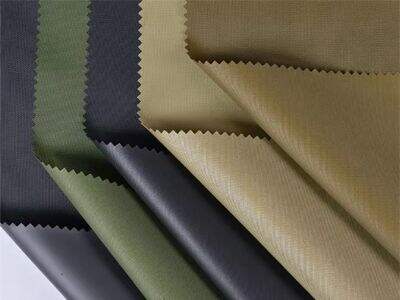Wanneer jy 'n idee in gedagte het vir enigiets projek wat jy kan dink van en jy is in behoefte aan 'n stof wat sterk en taai is, is Ripstop Nylon Stof die perfekte keuse vir jou. Lat ons kyk na alles wat hierdie stof so spesiaal maak en 'n regte gunsteling.
Wat is Ripstop Nylon Stof en Hoekom Is Dit So Populêr?
Ripstop Nylonstof is 'n ligwaterige maar stevige vezel. Dit word geweef van dikker draad: konstant, deurweef met dunner nylondraad. 'n Voorbeeld hiervan is om 'n spesiale weefsel te gebruik wat 'n byna onbreekbare stof skep. Daarom is dit 'n uitstekende keuse vir projekte wat vas materiaal benodig. Mense hou daarvan om Ripstop Nylon Stof vir tasse, tente, buitenshuis klere, vlagge en veel meer te gebruik. Dit word goed gemag omdat dit baie afrag kan verdrags sonder om afgeskryf te word.
Hoe om die regte Ripstop Nylon vir jou projek te kies?
Dit is egter belangrik om voorbeeldig te wees en sommige punte in ag te neem terwyl jy kies ripstop nylon stof vir jou projek. Eerstens, oorweeg die gewig van die stof. Die stof kom in verskeie diktes, so sal die gewig afhang van hoe swaarwerkend jou projek is. Byvoorbeeld, as jy 'n rugtas wil maak, sou jy 'n dikker en robuster tekstiel nodig hê.
Daarna, dink aan die stofkleur en patroon. Daar is talle goeie vaste kleure en leuke patrone. Dit kan iets helder en vrolik wees of iets meer gedempt, afhangende van wat jy suksesvol vind.
Laastens, as jou projek buite is, oorweeg dan die weerstand teen weer van die stof. Ander Ripstop Nylon Stowwe het ons waterdiggemaak en sonblootgestel sodat ons kon vergelyk hoe langer hulle sal standhoud vir jou projek.
My Naai Tippies en Truks vir Ripstop Nylon Stof
Soms kan naai met Ripstop Nylon Stof 'n bietjie trukkies wees, maar met hierdie wenke en trukke sal jy gou op weg wees om prachtige projekte te voltooi. Eerstens moet jy 'n baie skerp naal gebruik om te naai. Gebruik 'n fyn naal om vasryping of skade aan die stof te voorkom terwyl jy naai.
Tweedens is bindertape 'n uitstekende manier om die rande van die stof te versterk. Dit sal voorkom dat die rande uiteenval en jou projek langer netjies laat lyk.
En eenmalig jy klaar gestik is, kan jy die vlam van 'n aansteker gebruik om die einde van die drae voorzichtig te smelt en die nae 'n afgeronde voorkoms te gee wat ook help voorkom dat hulle uiteenval. Hierdie truk hou alles op sy plek en maak jou projek netjies en skoon.
Ripstop Nylon Stof: Voordake en Nadele
Soos enigiets ander stof, ripstop nylon stof besit dit voordele sowel as uitdagings. Latons 'n nouere blik werp.
Voordele:
Die kompakte grootte, dit is lig en onderweg.
Dit is redelik duurzaam en skeurrestitant, so kan dit baie gebruik hanteer.
Dit is waterdig, so dit sal 'n bietjie reën oorleef sonder om nat te word.
Dit is asemhalend en maklik om skoon te maak, so jy hoef nie te veel oor vuil of vlekke bekommerd te wees nie.
Nadele:
Dit strek nie so baie nie, wat dit moeiliker kan maak om mee te werk as jy 'n bietjie moet gee.
Dit kan vir beginners' n bietjie uitdagend wees om te naai, en daarom sal jy dalk eers' n bietjie wil oefen.
Nylon-fifonering kan duurder wees as ligter stowwe, en daarom moet jy seker maak dat jy die pryse vergelyk voordat jy een kies.
Maniere om jou eie Ripstop Nylon Stof in te sluit
So nou dat ons weet wat ripstop nylon stof is, hoe om dit te kies, en hoe om dit te naai kom ons kyk na 'n paar verskillende maniere om dit in ons daaglikse lewe te gebruik. Daar is baie oulike projekte wat jy met hierdie stof kan doen. Jy kan dit gebruik om 'n supersterk skoolrugsak te kry wat al jou boeke en toerusting kan bevat.
Voor diegene wat van kampen hou, kan jy moontlik 'n maklik-om-op te stel tent innoveer wat jou veilig kan hou vanweë die weer. Maak 'n kleurvolle vlerk wat hoog in die lug kan vlieg as dit 'n winderige dag is in die park.
Jy kan dit ook gebruik om saggies hondbedde vir jou huisdiere te maak, kleurvolle tafeldoeke vir familieëtese en selfs kleurvolle banere wat by partye en feeste opgehang kan word. Deur Ripstop Nylon Stof te gebruik, is die moontlikhede onbeperk.
Ten slotte is Ripstop Nylon Stof die uiteindelike goeie stof om te gebruik wanneer jy 'n stof skep wat duurzaamheid en sterkte vereis. Dit sal 'n bietjie meer uitdagend wees (wat 'n fantastiese ding is) om jou te leer hoe om 'n geskikte stof te kies, waarmee om dit te naai, en duisend-en-een maniere om dit in jou daaglikse lewe te integreer. So berei jou voor, pak jou spore en geniet die skepping.

 EN
EN
 AR
AR
 BG
BG
 HR
HR
 CS
CS
 DA
DA
 NL
NL
 FI
FI
 FR
FR
 DE
DE
 EL
EL
 HI
HI
 IT
IT
 JA
JA
 KO
KO
 NO
NO
 PL
PL
 PT
PT
 RO
RO
 RU
RU
 ES
ES
 SV
SV
 TL
TL
 ID
ID
 LV
LV
 LT
LT
 SR
SR
 SK
SK
 UK
UK
 VI
VI
 HU
HU
 TH
TH
 TR
TR
 AF
AF
 MS
MS
 GA
GA
 CY
CY
 HY
HY
 UZ
UZ




